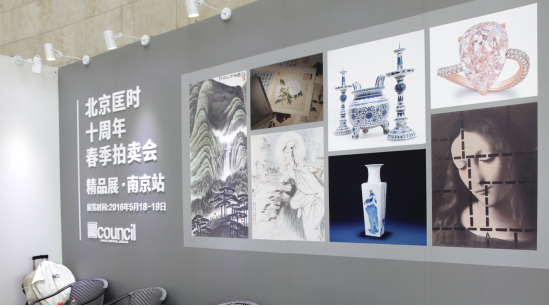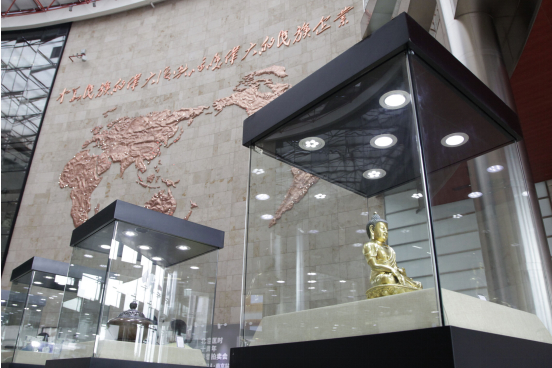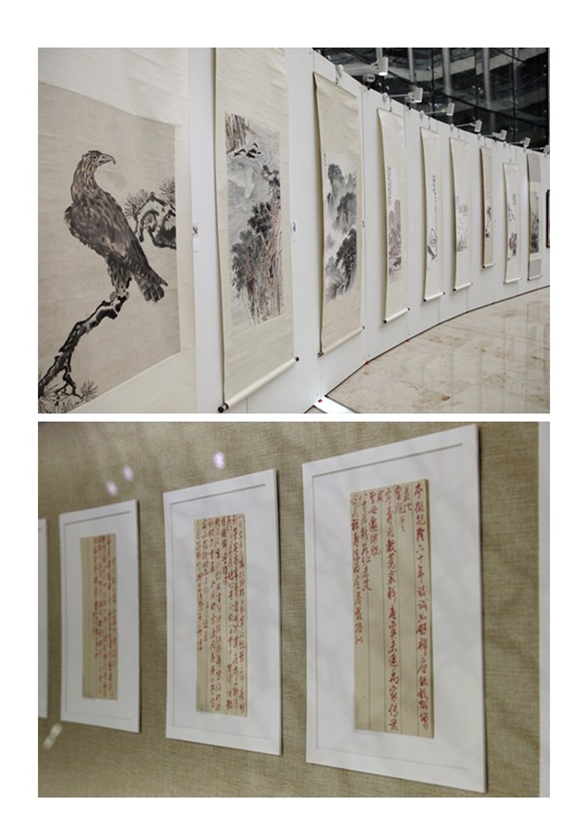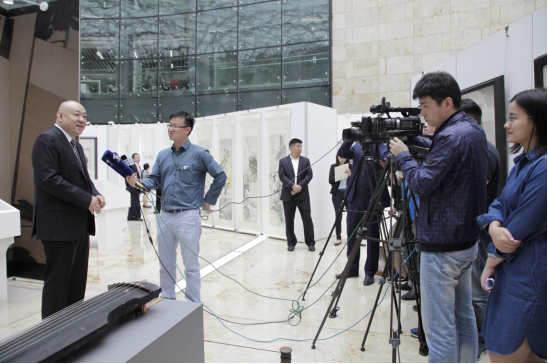Third Sanpower Culture and Art Festival opens with display of artwork valued at 10 billion yuan
Time Published:2016-05-27Source:Author:
Browse:0 Print
Font Size:LargeMediumSmall
The third Culture and Art Festival of Sanpower Group saw its grand opening on 18-19 May. More than 150 works from master artists with a total value of over 10 billion yuan were displayed in the showroom at the Sanpower headquarters. This generous exhibition was carefully curated by well-known Chinese auction house Beijing Council International Auction Company Ltd and offered a high-end art and cultural experience for Sanpower employees and Nanjing citizens.
The Sanpower Culture and Art Festival has now been held three times and is an important part of the Eight Ones Project that Sanpower Group has created for its employees to develop its corporate culture. This time the festival worked hand in hand with Beijing Council with the event held on a bigger scale and with better quality works than ever before. Meanwhile, it was also the first stop in Beijing Council’s 10th Anniversary Spring Auction Tour. Chinese painting and calligraphy, modern and contemporary art, porcelain Buddha statues, antiques and curios, red stoneware, Chinese stone carvings, jewellery and wristwatches and exhibits in other categories were on display.

Painting and calligraphy have always been the highlight of Beijing Council’s auctions. Beijing Council has carefully prepared its spring auction upon the 10th anniversary of its establishment and to that end it launched Qi Baishi Painting and Calligraphy Highlights and the Qing Dynasty Royal Calligraphy and Painting Highlights, with the fine works also displayed at Sanpower. Over 20 masterpieces by Qi Baishi were chosen for the Qi Baishi Painting and Calligraphy Highlights, among which was Eagle Standing on Pine Tree, painted when he was 86 years old and The Family with the Bean Shed, which used to be part of the collection of Zhang Zongxian. The tone for this piece of work is mainly red which speaks to the sunset in the poem inscribed on the painting. A number of calligraphy and painting masterpieces from the royal palace of the Qing Dynasty were selected for the Qing Dynasty Royal Calligraphy and Painting Highlights. Album of One Hundred Peonies by Jiang Tingxi, which was recorded in the official Qing government art collection record, made its auction debut.

The Legacy of Zhang Daqian: His Daughter’s Collection was supported by Zhang Xinrui, the eldest daughter of the artist. Over 20 paintings by Zhang Daqian were selected from her collection. Among them, The Lotus is a unique chi-pao dress which has been preserved by Zhang Xinrui; Zhang Daqian had painted a lotus on the white satin and then asked a tailor to sew the dress together. Zither for the Cold Pine Forest is the guqin that Zhang Daqian brought to Chengdu from Shanghai in 1948. He told Xinrui that it belonged to Jiang Baishi, a famous poet of the Song Dynasty, and asked her to practice hard, from which we can see his kindness and patience as a father. It allows us to see the style and personality of this master of art from another angle.

A few of the most important auction items were selected from the first Heavenly Creations: Fine Porcelain and Jade Artworks Highlights to be shown as part of the exhibition. In terms of curios and porcelains, vessels that could represent the highest levels of craftsmanship during three periods of the Qing dynasty – that of the Kangxi Emperor, Yongzheng Emperor and Qianlong Emperor – were selected.
During the show, a set of Chinese blue and white cups decorated with twelve flora that had not been seen in more than ten years was unveiled once more. This artwork is a type of eggshell porcelain from the Kangxi period of the Qing dynasty. Antique pottery expert Geng Baochang once called it “The cups of the twelve flowers for twelve months” in Appreciation of Porcelain of the Ming and Qing Dynasties. The cups are extremely thin and delicate, without handles, decorated in blue and white. The decorations represent the flowers of the twelve months and poetry and the word shang (which can be roughly understood as meaning “appreciation”) are also inscribed on the body. The cups are extremely famous and precious porcelains from the Kangxi Period.

In jewellery and luxury products, the 6.38 carat orange-pink diamond, 56.41 carat Sri Lankan non-enamelled sapphire ring, yellow diamond jewellery set and the emerald lucky bamboo pendant in particular caught the eyes of many visitors.
In addition, dozens of masterpieces by past masters were also carefully collected and displayed in the ancient painting and calligraphy section of the exhibition. The modern and contemporary art section saw Treasure Hunting: Modern and Contemporary Art Highlights launched for the first time. It provided a complete overview for collectors get to the essence of the development of modern and contemporary Chinese art. In the contemporary art section, there was the launch of four specials featuring furniture, red stoneware and health products, near-contemporary porcelain, contemporary jade carving, and stone carving. In total, a great many fine works were displayed in the exhibition.

This high-end culture and art exhibition not only enriched the spiritual and cultural life of employees, but also strengthened the foundation of the company’s corporate culture. The strong collection and open art exhibition format also attracted many art collectors from home and abroad. The head of Beijing Council noted that Jiangsu is rich in culture and history and has a strong tradition of art collecting. The exhibition in Nanjing “selected the best from the fine” and represented the highest quality works of the Beijing Council 10th Spring Auction.


A number of media outlets in Nanjing attended the exhibition. Dong Guoqiang, chairman of Beijing Council, accepted a group interview from Jiangsu media.


